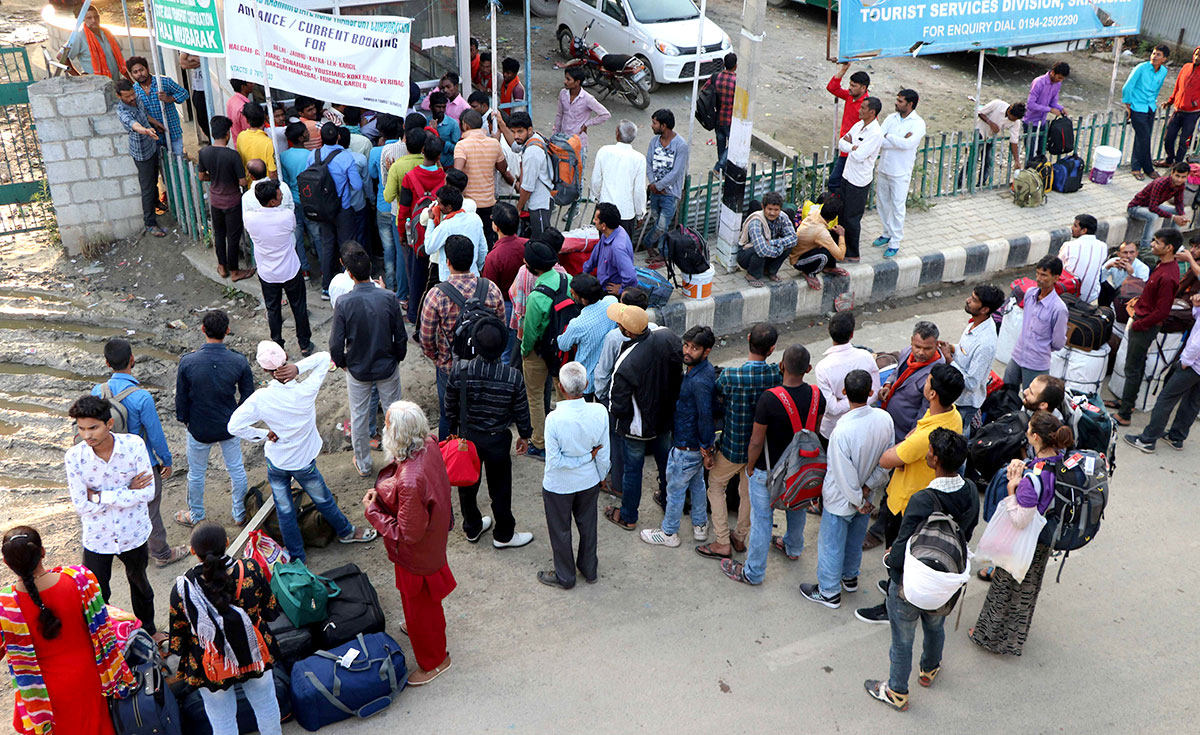Within hours after the government issued marching orders to the tourists and pilgrims ahead of August 5, tens of thousands of the non locals working in Kashmir left leaving behind unfinished works worth crores of rupees, reports Shams Irfan

Amid massive build-up of troops and constant rumours, a government order on August 2, asking tourists and Amarnath pilgrims to leave Kashmir immediately, triggered panic.
Within no time locals lined outside grocery stores and petrol pumps to prepare for the worst. But nobody knew what that would be. There were just anticipations.
As tensions mounted and uncertainty overtook routine, hundreds of thousands of non-native workers in Kashmir began packing their bags to leave. These included the entire skilled and semi-skilled lot that was part of Kashmir’s growth story.
With no clarity from the government this non-native workforce reached Tourist Reception Centre (TRC) in Srinagar, hoping to get a ride home. In next two days around 60 thousands labourers left Srinagar alone. There were issues of transport that prevented hundreds to stay on the footpaths, forcing the host population to arrange for their dinner in a community kitchen, the transporters and the hospitality professionals set up on emergency basis.
By Sunday evening almost fifty percent of non-native labourers in Kashmir had left, while rest struggled to find transport. In Khunmoh industrial area local trucks were pressed in service to ferry them out of Kashmir. All of a sudden, the rates soared.
“I had over fifty labourers working in factory and all of them have left,” said Younis, who runs a Plaster of Paris plant in Khunmoh. “They had closed the plant on their own which incurs huge loss at the peak of construction season.”
Most of the factory owners in Khunmoh have paid hefty advances to contractors who bring workers for them from Bihar, Uttar Pardesh, Jarkhand and other states. “We had paid lakhs of rupees at the start of the season for hundred labourers,” said another factory owner from Khunmoh. “With no communication I don’t know if they will ever come back.”
In late 1990s Kashmir saw a sudden shift in work culture when thousands of skilled and non-skilled labourers started to arrive from neighbouring states. They changed the way Kashmir worked. Their expertise and style of working helped them outwit local work force within no time. Despite ups and down in the militancy this work force worked without much trouble. Estimates suggest that around half a million non local workers come to Kashmir every spring. Most of them spent six to eight months, mostly in the real estate sector.
As the number of these migrant labourers surged, Kashmir struggled to accommodate them. This gave rise to a new wave of construction and investment by locals in small single room accommodations. Even small far-off village had over hundred rooms available at any given time for these workers. But on August 5, these rooms, still smelling of previous night’s dinner and tobacco, were empty.
As they left every single ongoing work across Kashmir came to a halt. The last leg of the Jehangir Chowk flyover was perhaps the last job these workers had completed when the situation led them to leave Kashmir. But there are many works which have not been completed.
“We were in the middle of construction of my house when my entire workforce left without informing,” said a resident of Chadoora.
By Monday morning, when Home Minister Amit Shah declared abrogation of Article 370 and 35A in Rajya Sabha, almost entire non-native workforce was gone from Kashmir.
There were no tailors, barbers, labourers, masons, carpenters, painters, mehandi artists, bakers, construction workers, skilled and non-skilled workers to be seen in Kashmir. They had all gone leaving behind a vacuum of work force.
Given the fact that Kashmir was in the middle of its marriage season, absence of skilled make-up and mehandi artists has further added to the crisis for would-be-brides and grooms. Now the demand is partially met by locals who have some level of understanding and skills. But what hit would-be-brides the most was sudden fleeing of non-native tailors. These tailors were working round the clock to meet deadlines for Eid-ul-Adha and the marriage season after that.
“I have my entire wedding material with a tailor in Srinagar,” said a would-be-bride from Anantnag. “I was supposed to pick it up on August 10, but now I don’t know what I will do, as my wedding date is approaching fast. I have learned that the tailor has left three weeks back,” she said in a concerned tone.
Over last two decades a number of non-native moulvis or imams, who after passing out from religious seminaries like Deoband and other places in Indian plains, came to Kashmir to lead prayers in local mosques, had left too. In Noorbagh, a non-native Imam was politely asked to leave by community elders as no one was ready to guarantee their safety in Kashmir anymore. “The situation is not like what we saw in 2016,” said a local from Noorbagh. “Now every non-native is seen with a certain level of suspicion by the locals.”
As curfew continued into second week people started visiting local barbers, a rare species in Kashmir now, to get in shape. These traditional barber shops, which would remain deserted as people rushed to shops run by barbers from Delhi and Uttar Pardesh, are now new gossip centre and always packed with customers. “We literally dragged a local barber from his home and asked him to work,” said Kaiser, resident of Noor Bagh in Srinagar. “He was initially reluctant but when he saw the rush outside his shop his face lit.”
In the days that followed a number of such traditional barbers began dusting their shops as customers were back after a decade long gap. “I had quit my father’s profession long back as it was hard to compete with outside barbers,” said Sajad, who became a taxi driver. “But for the last two weeks I have restarted my father’s barber shop. I am earning more than double of what I would earn as a driver.”

Sajad is not the only one who is retracing his professional roots in these difficult times. A number of skilled workers like carpenters, masons, plumbers and painters are trying to fill the vacuum left by the non-native workers.
“I was refurbishing my kitchen when workers left all of a sudden leaving work midway,” said a resident of Srinagar. “With construction material lying in my house I immediately called a local mason whom I knew and he was more than happy to finish the work.”
But the question remains that can these small acts of filling the gap sustain Kashmir’s large appetite of workforce that it has developed in last few decades.
With apple season harvesting season round the corner it will be a major crisis given the lack of workforce. Apple harvesting is a major labour intensive exercise as it has to be completed within a specific time frame. Any delay can cost a fortune. How the local workforce will help manage this deficit remains to be seen.














